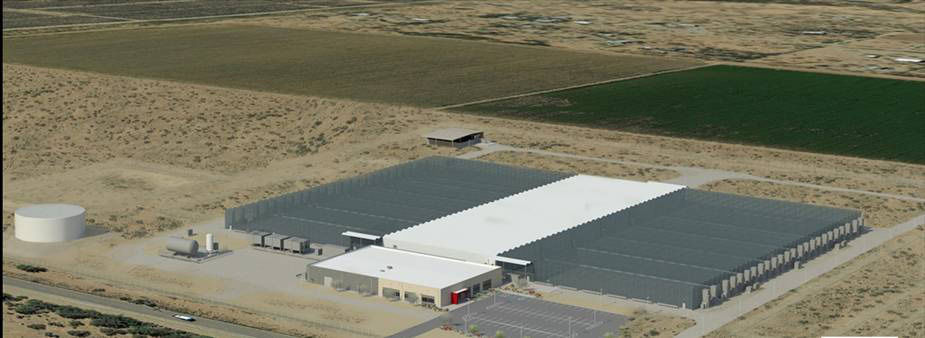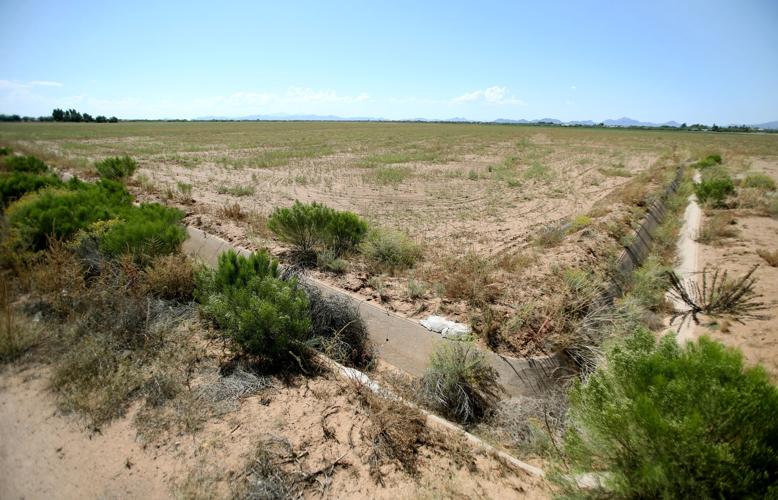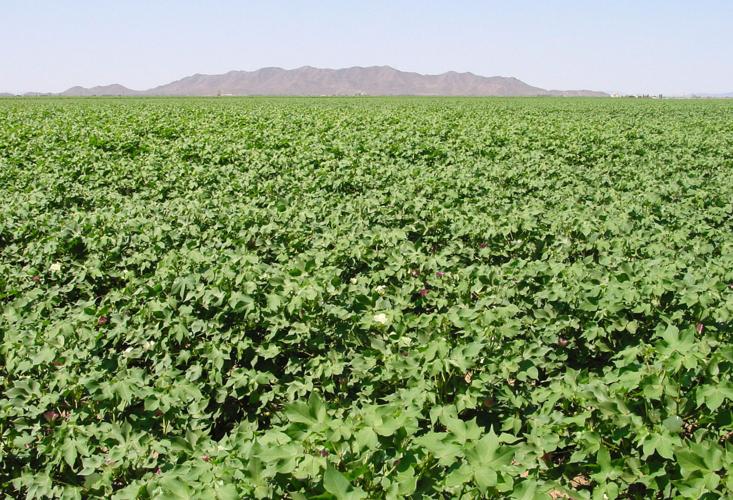A typical zoning hearing for a 7-acre subdivision doesn’t draw more than a handful of protesters — mainly people who live close by.
But on Tuesday, the Pima County Board of Supervisors expects to hear hours of objections to a 7-acre greenhouse that global biotech giant Monsanto Co. wants to put in rural Avra Valley, northwest of Tucson. Critics are upset not just about Monsanto’s plans to operate here, but also about County Administrator Chuck Huckelberry’s support of incentives that would reduce the company’s property taxes by two-thirds.
The company promises $95 million to $105 million in investments, 40 to 60 jobs paying an average of $44,000 a year and an emphasis on sustainability. It says the automated operation will use far less water and land and a fraction of the herbicides normally sprayed for an operation of this scale. The greenhouse will turn out a new generation of corn seed varieties, both conventional and genetically modified, that will help farmers around the world have more productive and resilient crops, Monsanto says.
Huckelberry, who wants the board to support Monsanto’s incentives, says that even after accounting for the tax breaks, the county will get far more tax revenue from the company’s 155 acres in the Avra Valley than it receives today on the vacant parcel.
Monsanto “will become the largest taxpayer in the Marana Unified School District,” Huckelberry wrote in a memo last month. “It will have twice the taxable value of the Ritz Carlton Hotel and Resort.”
In the past month, the district and the Joint Technical and Educational District’s governing boards passed measures supporting Monsanto’s application. Last week, Pima Community College’s Governing Board rejected one by a 3-2 vote.
The project will have no negative environmental impacts, Huckelberry says.
But critics — who have organized rallies and circulated petitions against the deal — say Monsanto’s presence would seriously damage Tucson’s burgeoning reputation as an international City of Gastronomy. UNESCO bestowed the title last December.
“We were just designated based on our long agricultural heritage. What that stands for is diversity. What Monsanto stands for is homogenization,” said Megan Kimble, managing editor of Edible Baja Arizona magazine, which spearheaded the push for the City of Gastronomy recognition — and which recently editorialized against tax incentives for Monsanto.
Opponents say it’s not fair for one of the world’s largest biotech firms — which will get much bigger if a proposed merger with Bayer AG is approved — to get major tax subsidies that local farmers don’t get. They don’t trust Monsanto to run an environmentally friendly and sustainable greenhouse, based on what they see as the company’s poor track record for transparency and honesty around the world.
At issue Tuesday will be whether supervisors support Monsanto’s application to the U.S. Commerce Department to expand an existing foreign-trade zone in Pima County. If Commerce approves the application, Monsanto gets the tax break.
University of Arizona scientist and local-food advocate Gary Nabhan objects to adding Monsanto and its GMO corn seeds to a foreign-trade zone that promotes trade with Mexico. He said Mexico’s scientific leaders oppose GMOs and its courts have banned certain genetically modified crops. Putting Monsanto in this area is like “putting a factory in a nature sanctuary,” Nabhan said at a rally held Thursday to oppose the incentives.
LESS WATER will be used, COmpany SAYS
Monsanto’s greenhouse would be part of a company effort to find the best, most-productive corn seeds . It will contain a blend of genetically modified seeds and non-GMO seeds, said Kyle Smith, a leader in Monsanto’s breeding activities. It eventually will grow 400,000 to 500,000 corn plants annually, all indoors, the company says.
“It’s the first time we’ve had a greenhouse with this level of sophistication,” Smith said.
The greenhouse essentially will be split into two. Two 3ƒ-acre sections will be glassed in, separated by 2ƒ acres that will hold irrigation and fertilizer tanks, soil media, potted plants, shellers to remove kernels from corncobs and driers to prepare seed for shipment. The 155-acre site will also have an office building, a 2 million gallon water tank for fire suppression and a composting facility. For now, at least, no outdoor corn-seed planting is planned, Monsanto says.
Monsanto has drawn complaints and lawsuits elsewhere that say its genetically modified seeds have blown from open fields onto other farms and contaminated those farmers’ seeds. Critics worry that could happen here, even with a greenhouse.
“It is a sealed greenhouse,” Smith countered. Ventilation will flow through the roof and floor, with roof vents covered by mesh tight enough to keep insects out or corn pollen from escaping, he said.
A similarly scaled corn seed operation in a field would use 250 acre-feet of water, Monsanto says, enough to serve at least 500 typical Tucson homes for a year. This project will use one-fifth that much from a well on the property, said Smith.
While that amounts to about 7 acre-feet per acre — far more than is typically used to grow corn or virtually any other crop in Arizona — that comparison isn’t valid for the greenhouse, Monsanto spokeswoman Christi Dixon said.
The greenhouse will grow corn plants twice as closely packed as they would be in an open field, she said. Because of Southern Arizona’s year-round growing season, the greenhouse can grow three generations of corn crops yearly — three times the norm.
Taking all that into account, the greenhouse’s water use should amount to 1.19 acre-feet per acre, she said. Monsanto will also install a system to recycle water the plants don’t take in, Dixon said.
Monsanto bought its land in October, prior to board approval but after discussing plans with county officials since March.
“We felt this had a good chance of being approved,” Smith said.
GMOS, CHEMICALS WORRY SOME SMALL FARMERS
Monsanto has no place in the nation’s first City of Gastronomy, said Debbie Weingarten, a board member for a local-food-advocacy group. She points to its use of GMOs and herbicides and a potential for corporate homogenization of agriculture to put small, organic farms out of business.
“Our UNESCO application directly pointed toward the rich history and culture of food production here, which goes back 4,000 years and is based around traditional crops and dryland farming by the Tohono O’Odham and their ancestors,” Weingarten said.
Weingarten serves on the board of the Pima County Food Alliance, a nonprofit that advocates for a secure food system that is environmentally sound. She also sits on the city of Tucson’s Commission on Food Security, Heritage and Economy, is a co-founder and board member of the local Farmer Education and Resource Network and is a former co-owner of Sleeping Frog Farms in the rural village of Cascabel.
In the past 20 years, this region has seen an upswing in local growers and food advocates who are “promoting a food system that values the connection between people producing food and people who consume food,” she said.
Like Sleeping Frog Farms, many local farms are certified as naturally grown, or organic, and are committed to growing food without using chemicals.
“Concern for water supply and pollinator population doesn’t seem to be a concern that industrial agriculture or specifically Monsanto shares,” she said. “My concern with a corporation coming that doesn’t have ties to this area would be that they have no long-term consideration. They don’t have to live here or drink the water.”
Maneesh Shah, a founder and co-executive director of Heirloom Farmers Markets Inc., watches Heirloom’s Rillito Market draw around 2,500 people on a typical Sunday. The market pays Pima County about $20,800 a year to lease space outside the Rillito Racetrack for food stalls, including at least 10 run by local and regional produce growers.
Shah says he has no problem with Pima County giving tax incentives to some big companies such as Caterpillar, which he says fits in with the region’s historic mining industry. But he’s not convinced that Monsanto’s corporate agriculture blends in as well.
“We’re less industrial. We care about our environment. I’m not sure Monsanto fits that,” he said.
He wants county supervisors to let the public decide whether to support its property tax incentives.Clay Smith, a co-owner of Sleeping Frog Farms, says he wants the county to treat his business as well as it’s treating Monsanto. “They bring in $100 million in investments, but look at what local farmers’ markets generate,” he said.
“We grow food for taste, nutritional value, for freshness, not mass production or for shipping. We sell 100 percent of our food within 100 miles, at farmers markets and through direct marketing to three dozen restaurants, co-ops and Community-Supported Agriculture customers.”
Larry Parks, owner of Larry’s Veggies at Rillito Market, neither supports nor opposes giving Monsanto incentives, but he said small growers should get used to it.
“Organic farmers aren’t going to get support from the government,” said Parks, who grows a wide range of vegetables without pesticides. “Monsanto is going to invest $100 million. If I had $100 million, I wouldn’t be doing this. So they deserve a little tax break. That’s a lot of money coming into this county.”
ECONOMIC IMPACT
Despite the controversy around Monsanto’s use of genetically modified organisms, “Pima County has not identified any negative air quality, water quality, water supply, transportation capacity or natural resource impacts from the facility,” Huckelberry said in his memo to supervisors last week. “Furthermore, the county cannot regulate an agriculture operation based on state law.”
Assuming the company invests $95 million, its estimated county primary and secondary property tax bill for the first year would be nearly $190,000, according to county calculations obtained by the Star through public-records requests. Without the foreign-trade-zone designation, that bill would be more than $500,000. The previous owners paid just shy of $2,000 in 2015 property taxes on the undeveloped agricultural land.
The economic impact of the project is estimated at around $280 million between 2016 and 2025, according to an analysis conducted by Sun Corridor Inc., a privately and publicly funded economic-development firm.
To address environmental concerns, Huckelberry proposed creating two commissions to look for potential adverse impacts and separate “fact from fiction” about the company.
One commission would focus on agricultural science, the other on social and policy concerns. Monsanto would pay up to $50,000 annually for any research or technical analysis deemed necessary by the science commission.
Benefits questioned
Sylvia Lee, a member of the Pima College Governing Board, voted against a motion supporting Monsanto’s foreign-trade-zone designation to align her vote with her values, “which have a lot to do with the public good and public health.
“I’m concerned that genetically engineered foods haven’t produced the benefits that were touted years ago,” Lee said
One reason she voted against the designation was a recent New York Times article. Evidence doesn’t show that the production of genetically modified foods has increased crop yields or reduced herbicide use, the story said. It cited United Nations data in comparing results from Europe, which 20 years ago largely rejected the growing of genetically modified foods at the same time the United States and Canada were approving it.
“Comparing results on the two continents, using independent data as well as academic and industry research, shows how the technology has fallen short of the promise,” reported the Times.
In response, Monsanto accused the newspaper of cherry-picking data and of overlooking the perspectives of farmers worldwide who choose to use GMOs. The company said making comparisons across broad areas is difficult because of differing crop maturity rates and overall traits of the regions’ agriculture. It said USDA statistics show that soybean and corn yields in the U.S. have actually risen around 28 to 30 percent in the GMO era since 1996.
View from Marana’s cotton fields
Some conventional cotton farmers in the Marana area say they have no problem with Monsanto’s greenhouse plans and appreciate what its technology has done for their operations. But they’re split on whether the company should get local tax incentives.
Pima County, with its mining cutbacks and other jobs setbacks, shouldn’t even be debating the incentives, but should “have its arms wide open for 50 good-paying jobs,” said Marana cotton farmer Arnold Burruel.
Another longtime Marana farmer, Tom Clark, said he’s not convinced that a company Monsanto’s size needs tax incentives.
“The county is not in that good of a financial position. I just think they ought to be putting their money into fixing the potholes and fixing the roads,” Clark said.
But Clark said he’s not concerned about seed contamination from Monsanto because he believes the greenhouse will be effectively sealed. He and “everybody I know of in Marana” uses GMO seeds to grow cotton, he said. He uses seeds that are resistant to pink bollworm — at one time a serious threat to cotton crops — and said that, due to the GMO cotton, he sprayed his fields once last year, rather than seven to eight times like he used to.
Marana’s continued encroachment onto farmland concerns him far more than a 7-acre greenhouse, Clark said. Like another farmer told him, “The last crop a farmer wants on his ground is houses.”







